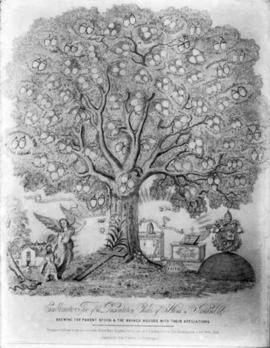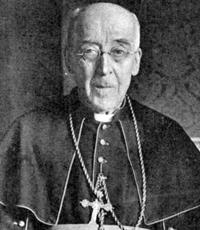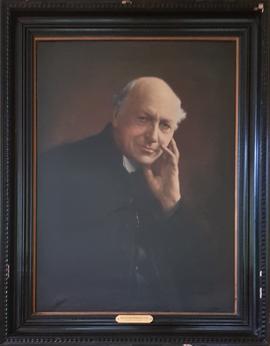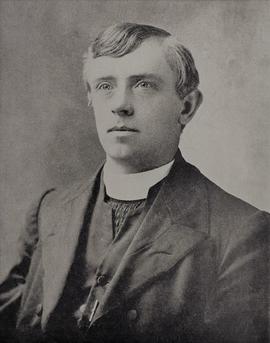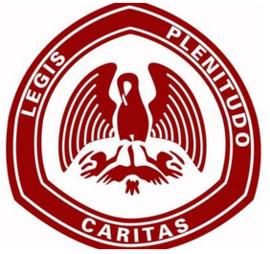Apostolic Nuncio to Ireland, 1930-1948 https://en.wikipedia.org/wiki/Paschal_Robinson
Bishop Daniel Mageean D.D. 6 May 1882 – 17 January 1962 was an Irish Roman Catholic Prelate and until 1962 he held the title Lord Bishop of Down and Connor.
Daniel Mageean was born in the townland of Darragh Cross in the parish of Saintfield, Co. Down and received secondary education at St Malachy's College and St Patrick's College, Maynooth. He was ordained priest in 1906.
His older sister Mary (McCall) became the first President of the Apostolic Work in 1924 indicating the faith and commitment of his wider family where there were others vocations to religious life. While his mother was a sister of the late Dr Richard Marner, who served as President of St. Malachy's College from 1866 – 1876 and then Parish Priest of Kilkeel until his death in 1906.
His first pastoral appointment was a summer curacy in Glenavy parish in July 1907 and on 1 September that year he was transferred to St Malachy's College where he taught both English Literature and Latin and served as Dean of Discipline.
In 1919 Fr Mageean he appointed Junior Dean at St Patrick's College, Maynooth becoming Senior Dean in 1925.
On 31 May 1929 he was nominated Bishop of Down and Connor and received episcopal consecration in St Patrick's Church, Belfast on 25 August 1929.
In the 1930s he was a champion of Catholic rights especially after the anti-Catholic riots of 1935. He claimed that almost 400 Catholic families, totally nearly 1600 people had been driven from their homes. Dr. Mageean succeeded in getting the anti-Catholic nature of much of Northern Ireland life raised in the House of Commons at Westminster but his efforts came to naught and he resigned himself to a long period of sterility as prime ecclesiastical leader of demoralised Northern Irish Catholics.
A flavour of the struggles Bishop Mageean faced are considered in Jonathan Bardon's magisterial work on this history of Ulster. Bishop Mageean often used his Lenten Pastoral letter to address issues of wider social and political concern e.g. his 1938 letter on Partition and the persecution of Catholics in Northern Ireland.
He died on 17 January 1962 and was succeeded by the Bishop of Clonfert, William Philbin.
The Mageean Cup awarded annually to the winners of the Ulster Colleges' Senior Hurling Championship is named after him
Richard Bodkin was born in Limerick in 1846.
He died 29 March 1925.
Biographical notes for him in Colloque No. 58, mentioning the portrait visible above, are as follows:
'Richard Creagh Bodkin (Castleknock, 1925, aged 79) was born in 1846
in Limerick. He was educated in Castleknock, spending eleven years
there from the age of ten till the end of his philosophy! He joined the
community in Paris in 1865. He was ordained in 1870 and was appointed
to St Vincent’s Seminary, Cork. After five years he was appointed to
Castleknock, and remained there until his death fifty-five years later.
He was vice-president for sixteen years and prefect of studies for two,
but most of his half century there was as a teacher. Science was his
main subject and he gradually built up an excellently equipped science
hall, mainly with his personal money. He also used his money for the
purchase of library books. Later on he taught senior religion classes, and
published The Great Fundamental Truths of Religion, of which a new
edition came out in 1911. He also published How to Reason, or the ABC
of Logic (1906) and Logic for All (1911). He stocked the priests’ library
with very well-chosen books. When Monsieur L Beyaert of Bruges (first
name not known to me) was staying in the college painting the Stations
of the Cross he was intrigued by Fr Bodkin, and he used to observe him
closely at meals. He decided to paint his portrait secretly, and when he
had finished the Stations and was leaving, he presented his portrait of Fr
Bodkin to the college.'
Richard Henebry (Risteard de Hindeberg) was born on 18 September 1863 in Portlaw, County Waterford, the fourth of six children of Pierce Henebry, a farmer, and Ellen Henebry (née Cashen) of Clogheen in County Tipperary. At the age of twenty-one, Richard Henebry entered St. John’s College in Waterford to study for the priesthood, where Canon Patrick Power (1862-1951) was among his contemporaries. He subsequently won a scholarship to finish his studies in St. Patrick’s College, Maynooth. He graduated from All Hallows College in Dublin in 1892. Henebry briefly served on the English mission before he was offered the inaugural Chair of Celtic Studies at the Catholic University in Washington in 1895. The Ancient Order of Hibernians, an Irish American Catholic organization, had funded the chair and Henebry was proposed by classmates Canon Patrick Augustine Sheehan and Fr. Michael Hickey for the appointment. To fully prepare for his role Henebry was given special leave to go to Germany to study, again with effective lobbying on his behalf by Hickey and Sheehan. He studied for his doctoral degree in Celtic philology in Freiburg and Greifswald with the acclaimed celticists Rudolf Thurneysen and Heinrich Zimmer.
Henebry took up his appointment at the Catholic University in Washington in 1898 only to be relieved of his duties within two years. Though he was suffering from ill-health, Henebry had also seemingly fallen out with his colleagues and superiors in Washington. A diagnosis of tuberculosis forced him to spend a year recuperating in a sanatorium in Denver, Colorado. While in America, he edited and translated a large part of the life of Colum Cille by Manus Ó Donnell which he published in ‘Zeitschrift für celtische Philologie’ (1901-05). Following his return to Ireland, Henebry taught Irish in a variety of places in the Waterford area, notably during the summers from 1906 at Ring College (Coláiste na Rinne), which he had helped establish in 1905. Various diocesan appointments followed within Waterford and Lismore, before he put his name forward for the Chair of Irish Language and Literature at University College Cork (UCC) in 1909, again an inaugural position.
Henebry remained at UCC until his death in 1916, but it was not a wholly successful appointment. His efforts to embed his model of Irish language teaching in the university were met with resistance, from students and others. His efforts to establish an archive of Irish traditional music were also thwarted, and his continuing ill-health compromised his own ability to achieve these objectives. During his lifetime, Henebry was recognized as a leading linguist, and his works on the Déise dialect of Irish were widely acclaimed in academic circles. Pedagogically (and perhaps culturally) an enduring part of his legacy was his role as a teacher at, and supporter of, Coláiste na Rinne, in the Waterford Gaeltacht. In addition to his language instruction, Henebry also taught Irish traditional music to any students who were interested. He also relished his role as a contributor to various papers and periodicals, however the longest of his musical works published during his lifetime was a booklet, ‘Irish Music: Being an Examination of the Matter of Scales, Modes and Keys with Practical Instructions and Examples for Players’ (1903). Henebry died on 17 March 1916 in Portlaw, County Waterford, and was buried in Carrickbeg near Carrick-on-Suir. Henebry’s analytical monograph, ‘A Handbook of Irish Music’ (1928), published by University College Cork, appeared posthumously, and was edited by Professor Tadhg Ó Donnchadha (1874-1949), his successor in the Department of Irish in UCC.
Administrative and Biographical History
The Institute of Charity is a Roman Catholic religious congregation, founded in the early nineteenth century by Antonio Rosmini. The members of the order are referred to as “Rosminians” after their founder. The Congregation was approved by the Pope Gregory XVI in September 1839. As of the year 2020 the order Congregation is divided into six provinces. These provinces are the Irish-American Province, the Province of the England, Wales and New Zealand, the Italian Province, the Indian Province, the East-African Province and the Venezuelan Province. The world headquarters of the Institute of Charity is located at Rosmini College, Porta Latina, in Rome, Italy. The leader of the Institute of Charity is referred to as the Father General or sometimes as the Provost General. There have been eleven Fathers General with Antonio Rosmini being the first. They are (with years they were Father General):
Antonio Rosmini (died 1855)
Giambattista Pagani (1855-1860)
Piettro Bertetti (1860-1874)
Giuseppi Cappa (1874-1877)
Luigi Lanzoni (1877-1901)
Bernardino Balsari (1901-1935)
Giuseppi Bozzetti (1935-1956)
Giovanni Gaddo (1956-1989)
Giambattista Zantedeschi (1989-1997)
James Flynn (1997-2013)
Vito Nardin (2013-Present)
The Father General traditionally remained in his position until his death however in more recent times, the Father General may resign at 75. If the Father General wishes to not continue a vote by the curia is held to decide if this wish can be granted.
The Irish Province was founded in 1931. The first Rosminians in Ireland were led by a missionary named Aloysius Gentili who arrived to preach in 1848. Gentili died shortly after arriving in Dublin and was buried in Glasnevin Cemetry. His remains were later moved to Omeath in county Louth close to St. Michaels School which was ran by the Institute of Charity. The Irish Province has changed boundaries numerous times and at one time or another incorporated England, the United States of America, and New Zealand. Since 2019 the province consists of the island of Ireland and three houses in Florida. The province is controlled by a provincial and a provincial council who meet to discuss matters within the province. Past provincials include:
1. Thomas Hickey (1931-1948)
2. John Hickey (1948-1955)
3. Hugh MacFadden (1955-1964)
4. Benedict Forsyth (1964-1973)
5. Bernard McNally (1973-1976)
6. Charles O Sullivan (1976-1985)
7. James Flynn (1985-1991)
8. Patrick Pierce (1991-1997)
9. Matthew Gaffney (1997-2003)
10. Joseph O Reilly (2003-2010)
11. David Myers (2010-2014)
12. Joseph O Reilly (2014-Present)The term held in the role of provincial is currently for a period of six years before new elections take place to decide the successor.
The Institute of Charity has owned numerous buildings across Ireland throughout its history. Each building fulfilled a different function with some changing function numerous times throughout their history. The buildings whose records are included in this collection are:
• St. Michael’s, Omeath, County Louth.
• St. Joseph's School for the Blind and other Drumcondra buildings.
• St. Joseph’s, Ferryhouse, County Tipperary.
• St. Patrick’s, Upton, County Cork.
• Glencomeragh, County Tipperary.
• Kilmurry House, Kilworth, County Cork.
Omeath
St. Michaels in Omeath, Co.Louth, came into the possession of the Institute of Charity in 1901 following the death of its previous owner, Edward MacCreanor, who wished to bequeath the building to a religious congregation. The building acted as a novitiate for the Rosminians in its early days before later becoming a juniorate in 1927. The diary from St. Michaels contains some interesting events from its early days as a novitiate including a visit in August 1921 by Margaret Pearse, mother of the Easter Rising rebel Pádraig Pearse, visits by Black and Tans during the Irish War of Independence, reaction to the Anglo-Irish Treaty ratification in January 1922, and a raid by Free State soldiers in September 1922. Several improvements were made to St. Michael’s in the early days of Rosminian ownership including the installation of a new altar, the construction of the Calvary in 1908, the gifts of statues and the opening of St Michael’s as a Juniorate in 1927. In 1954 St. Michaels was recognized as a secondary school for boys, while girls were also allowed enter the school. It was primarily a boarding school however day students also were taught at the school. The school would close in 1986. The Rosminians also owned other property nearby to St. Michaels including a house in Fane Valley and numerous fields on the Cooley Peninsula. The Rosminians were also put in charge of Faughart Parish in County Louth in 1986 which they continue to run as of the year 2020.
Kilmurry House
The Rosminians bought Kilmurry House in Kilworth, Co. Cork, in 1931 after getting approval from Robert Browne, Bishop of Cloyne, to purchase the property in order to set up a novitiate. Correspondence and memorandums included in this collection relating to these negotiations with the Bishop of Cloyne highlight the processes religious congregations had to go through when wanting to purchase land in a diocese. After setting up the novitiate the Institute of Charity spent money on renovating the building as well as purchasing land nearby. The building sustained substantial damage following a fire in April 1953. The Institute of Charity sold the building in 1972. The Kilmurry House collection consists of a substantial number of letters and application forms from boys who wished to join the novitiate. These records have been arranged in alphabetical order of the boy’s names. The application forms contain information on each boy's family including the names of their parents, their addresses, the primary schools they attended, their dates of baptism, and their date of confirmation. Letters of recommendation from parish priests and family doctors are also included with the applications. The boys in their correspondence with the rector in Kilmurry explain their reasons for wanting to join the Institute of Charity and some also describe their family life and the occupations of other family members. Another important item of note is a catalogue of names of members of the Institute of Charity and students who attended the novitiate at Kilmurry House, County Cork between the years 1933 and 1937. This catalogue includes the age, rank, and the date of entry into the novitiate of those who resided there.
Glencomeragh
Glencomeragh was purchased by the Institute of Charity in 1960 and became a novitiate. A report contained in the Glencomeragh Collection describes the importance of Glencomeragh House during the founding of the Hospitaller Order of St. John of God in Ireland. While under the ownership of the Rosminians the building had heating installed while a new chapel was constructed between 1981 and 1983. The Rosminians also owned other properties near Glencomeragh House which they rented out. In later years Glencomeragh House was used by the
Institute of Charity as a retreat centre and as a House of Prayer. In later years a major upgrade in the House of Prayer was the construction of hermitages on the property’s grounds to be used by those on retreat. The Institute of Charity handed over Glencomeragh House to the Diocese of Waterford and Lismore in 2016 and it is now being ran by the Holy Family Mission as a retreat centre for young adults.
Ferryhouse
St. Joseph's Industrial School in Ferryhouse, County Tipperary was constructed by Count Arthur Moore. Completed in 1884, Moore handed over ownership of the school to the Institute of Charity shortly after the completion of the building. The Rosminians also purchased land at nearby Tickincor. The Ferryhouse collection contains important documents related to the details of boys who were placed into the care of the Institute of Charity throughout the history of the Industrial School including lists of boys who were accepted and discharged from the school and medical reports. The collection also contains examples of activities the boys carried out in the school, day trips undertaken and material from school plays.
A series of newspaper reports also explain important events which took place in St. Joseph's Industrial School including a visit by Patrick Hillery, President of Ireland, in August 1984; the opening of a £1,000,000 new complex at Ferryhouse in January 1983; reports regarding craft work and classes in arts and crafts in Ferryhouse; an early newspaper report concerning the qualifications for the teachers involved in the school, the public perceptions of institutions like the school at Ferryhouse and the training offered to the students. Items such as menus provide information on the types of food eaten by the boys in St. Josephs while newspaper articles, while reports contain information on the conditions inside the school and the types of punishments the boys faced if they disobeyed the rules.
Other associations became important to the functioning of the industrial school in Ferryhouse. This included the Resident Managers Association and the Association of Workers in Childcare. The Resident Managers Association was formed primarily by heads of religious institutions which had the responsibility for caring for neglected and poor children while the
Association of Workers in Childcare catered for residential child care workers in Ireland and was primarily concerned with the maintenance of standards of child care and of training for the profession in the country. Records relating to both associations are contained in the Ferryhouse Collection.
As well as the running of the Industrial School the Institute of Charity purchased and rented out property and land close to Ferryhouse. This included property in Laganore, Tickincor, Glenconnor, Poulboy and Clonmel. Henry Shannon and Co. solicitors from Clonmel, Co. Tipperary, assisted the Institute of Charity regarding issues that arose concerning the renting and sale of these properties. The Ferryhouse collection also includes the legal documents and folios containing the agreements and the property details of the properties owned by the Institute of Charity close to Ferryhouse.
St. Joseph's Industrial School was transferred to the Department of Education in 2002. Documentation regarding the transfer is included in the Ferryhouse collection.
St. Joseph's School for the Blind
St. Joseph's School for the Blind, now known as Childvision, is located on Gracepark Road in the Dublin suburb of Drumcondra. The school was founded by the Discalced Carmelite Order who began their work with the blind in Glasnevin in 1859 before moving to the current site in 1882. By 1953, a reduction in their personnel meant that the Carmelites were no longer able to maintain this service and the Archbishop of Dublin, who was the patron of the Carmelites, approached the Superiors of the Institute of Charity to take over the running of the school. After taking over the school the Institute of Charity expanded the facility with the construction of new buildings in the 1960s. By the 1970s a secondary school, Pobailscoil Rosmini, had been established on Gracepark Road alongside the School for the Blind. Boys who attended the School for the Blind could complete their secondary education. By the mid-2000s further expansion of the school was proposed. The Drumcondra collection contains extensive material on proposed plans, minutes of meetings and correspondence between government, contractors and the Board of the School for the Blind concerning the creation of National Centre for the Blind on the site of School for the Blind. This never materialised.
A number of other properties were owned by the Institute of Charity in Drumcondra including 2 Grace Park Gardens and 1 Grace Park Gardens. These properties were rented out to various organisations, details of which are included in the collection. Clonturk House on the Ormond Road in Drumcondra is the current provincial house of the Institute of charity in Ireland. Before becoming the provincial house, it was as a centre for blind adult men. The Drumcondra collection contains mostly administrative documentation on Clonturk House including financial documentation, a speech from the silver jubilee of Clonturk House about the history of the building, medical reports on the men who were cared for there, and mass books.
Africa
The Institute of Charity have been carrying out missionary work in the African country of Tanzania since they first arrived there in 1945. The African collection contains correspondence between the early Rosminian missionaries in Tanzania and Thomas Hickey, Provincial of the Irish Province of the Institute of Charity, describing their journeys to Tanzania, mostly by boat, the conditions they met when they arrived in Tanzania and the work, they had carried out following their arrival. A diary written by Frank Kennedy describes in detail his journey by boat and train from Dublin to Tanzania between November 1945 and December 1945. Another diary written by an unknown author documented the early days of the mission in Rangwe, Tanzania, in the arrival of Walter Dick and John Reid and the famine conditions faced in Tanzania throughout 1953. The collection also contains photographs, estimated to have been taken in the 1960s, which show examples of the missionary work being carried out in Tanzania as well as the customs and traditions of the Tanzanian people including a traditional Tanzanian wedding.
Aid was important for the continuation of the missionary work carried out by the Institute of Charity in Tanzania. There was frequent correspondence between the Rosminians and aid organisations such as Gorta and the Department of Foreign Affairs of the Irish government in order to secure aid for the missionary work. Aid contributed towards improvement in educational facilities, agriculture, the construction of mills, the construction of an arts and crafts centre, and electricity and water infrastructure. Meetings of the African Chapter were also frequently held and discussions were had on formation in Africa, preparations for religious festivals, relations with the Irish Province, and the beatification of Antonio Rosmini.
Carmelites
The Discalced Carmelites played a part in the history of the Institute of Charity. The history of the discalced Carmelites in Drumcondra and also in areas such as Glasnevin and Clondalkin have been preserved in this collection thanks to Patrick Keaveney and Vincent Corcoran, both discalced Carmelites who kept documents, items and photographs related to the Carmelites going back to 1825. The discalced Carmelites were present in monasteries in Glasnevin and Clondalkin. The oldest documents included in this collection include the transfer of obedience of the Carmelite Brothers of Clondalkin to the Archbishop of Dublin in August 1837, lists of members of the Discalced Carmelites who died in the monasteries in Drumcondra and Clondalkin between 1828 and 1963 and correspondence regarding the construction of an avenue to Glasnevin Cemetery in the 1830s on land belonging to the Carmelites. The discalced Carmelites founded St. Joseph's School for the Blind in Glasnevin before moving to Drumcondra on the site of Drumcondra Castle. The collection includes receipts containing information on construction work that was carried out in the school in Drumcondra including the construction of a staircase and of new buildings. Other documents include more personal documents belonging to Carmelite Brothers including death certificates, birth certificates, wills, and personal correspondence. The discalced Carmelites also owned properties in Dublin that they rented including properties on Prussia Street. In 1955, St. Joseph's School for the Blind was transferred to the Institute of Charity following negotiations between the Archbishop of Dublin, the Institute of Charity and the discalced Carmelites. It was agreed that the remaining Carmelites would continue to be resident in St. Joseph's following the takeover by the Institute of Charity. This collection is an important collection regarding the early history of the School of the Blind in Drumcondra and the education of blind men and boys in Ireland during the nineteenth century.
The Congregation of Our Lady of Apostles (OLA) was founded in Lyon in 1876 by Father Augustine Planque and immediately began to recruit girls in Ireland. The Irish Sisters would eventually settle in Ardfoyle Convent in Ballintemple, Cork from 1913 onward and became their own OLA Province on the 25th of November 1930. The Irish Province was initially comprised the OLA houses in Ireland, the Vicariate of Benin, and the Vicariate of Niger, with the latter of these two now being present day Nigeria. Sometime between 1930 and 1938 the OLA communities in the Gold Coast, now modern day Ghana, were included in the Irish Province. In 1950 the Irish Province began assuming responsibility of the French Generalate’s convents and foundations in England starting with their house in London, followed soon after by their property in Lancaster in 1953. For three years from 1949-1952 the Irish OLA had a foundation in Niger where they were involved in primary school education, and in 1957 the Irish Sisters began a new foundation in the United States.
In addition to setting up their own foundations, the Irish Province also assisted in the work of other OLA communities abroad in Egypt, Algeria, France and Argentina. And in 1974 the Irish Province sent their own sisters to help staff hospitals in Kenya and Zambia. In the 1990’s the original foundations in Nigeria and Ghana became self-sufficient and independent OLA provinces of their own, and so, the Irish Province opened a new frontier in Tanzania in 1991, and also sent Sisters to South Sudan to aid refugees where they remained until 1997. In 2024 the Irish Province became an OLA District alongside Tanzania with both Districts being independent.
Baptismal name: Patrick B. Brennan
Religious name: Fr. Benignus Brennan OFM Cap.
Date of birth: 14 July 1875
Place of birth: Paulstown, County Kilkenny (Diocese of Kildare & Leighlin)
Name of father: James Brennan
Name of mother: Mary Anne (Margaret) Brennan (née Byrne)
Date of reception into the Capuchin Order: 1 Jan. 1891
Date of first profession: 2 Feb. 1892
Date of final profession: 11 Oct. 1896
Date of ordination (as priest): 8 Jan. 1899
Missionary activities: Travelled to Harrisburg, Pennsylvania, United States, in 1911
Date of death: 15 Apr. 1950
Place of death: Wilmington, Delaware, United States
Place of burial: St. Patrick’s Capuchin Friary, Wilmington, Delaware, United States
From the ‘Necrology of the Western American Province’ (2005):
Patrick Brennan was born in Paulstown in County Kilkenny on 14 July 1875. He was given the name Benignus upon joining the Capuchin Order in 1891. Benignus was remembered as an outstanding preacher and retreat master. This was his principal ministry. He also wrote articles for the ‘Homiletic and Pastoral Review’ and other publications. Most of his life was spent as a member of the community at St. Patrick’s Friary in Wilmington, Delaware, from the 1920s until his death in 1950. In the 1930s he was an associate pastor for a short time in the friary in Lincoln, Nebraska. He was there when fire destroyed the friary on 8 January 1933 severely injuring Fr. Raphael Quinn OFM Cap., the pastor. Benignus was a great community friar and a helper to all those in the community. He died in the Wilmington Friary on 15 April 1950 and was buried in the cemetery attached to the house.
Baptismal name: Edmond (var. Edward) Connery
Religious name: Fr. Timothy Connery OFM Cap.
Date of birth: 4 July 1908
Place of birth: Ballylanders, County Limerick (Archdiocese of Cashel & Emly)
Name of father: Edmond Connery
Name of mother: Catherine Connery (née Barry)
Date of reception into the Capuchin Order: 4 Oct. 1926
Date of first profession: 5 Oct. 1927
Date of final profession: 5 Oct. 1930
Date of ordination (as priest): 17 June 1934 (Letterkenny, County Donegal)
Missionary activities: Travelled to Northern Rhodesia (now Zambia) in 1935. He returned to Ireland in 1938.
Date of death: 20 Jan. 1996
Place of death: Kilkenny
Place of burial: Foulkstown Cemetery, Kilkenny
Baptismal name: Joseph Andrew O’Connell
Religious name: Fr. Vivian O’Connell OFM Cap.
Date of birth: 2 Mar. 1914
Place of birth: 12 Claude Road, Drumcondra, Dublin
Name of father: Michael O’Connell
Name of mother: Kathleen O’Connell (née Kelly)
Date of reception into the Capuchin Order: 3 Oct. 1932
Date of first profession: 4 Oct. 1933
Date of final profession: 4 Oct. 1936
Date of ordination (as priest): 23 June 1940
Educational attainments: BA (1936)
Missionary activities: Travelled to California, United States, in 1946
Date of death: 21 June 1952
Place of burial: Holy Cross Cemetery, California, United States
From the ‘Necrology of the Western American Province’ (2005):
Joseph O’Connell was born in Dublin on 2 March 1914. On joining the Capuchins, he took the name Vivian in religion. Our information on Fr. Vivian is unfortunately very limited. After his ordination in 1940 he became Vice Master of Novices at Rochestown Friary in County Cork. He was sent to the American mission in 1946 and was assigned to minister at Blessed Sacrament parish in Elk in California. Shortly after arriving, he became ill and was diagnosed with cancer. He was transferred to Our Lady of Angels parish in Burlingame for treatment. He spent some time in hospital and died on 21 June 1952. He was buried in Holy Cross Cemetery in Colma in California.
